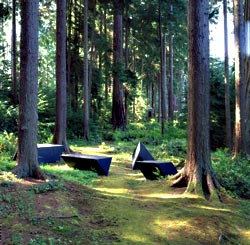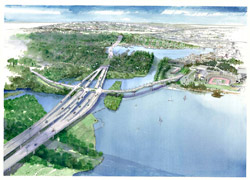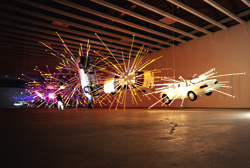It’s ironic that the hill the city spent 32 years flattening is being rebuilt 100 years later for the sake of art. The Seattle Art Museum’s 8.5-acre Olympic Sculpture Park, scheduled to open in the fall, is taking its tiered shape on what was once part of the Denny Regrade project (1897–1914).
In recent months, SAM has had to regrade some of its own publicity bumps. The $85 million project ran into controversy late last year after it caused the demolition of the trolley barn on Broad Street, thus stopping the popular waterfront service. Then one of the project’s prize commissions was pre- emptively attacked by KOMO-TV’s Ken Schram and KIRO radio’s Dori Monson. Both found undertones of pedophilia in Louise Bourgeois’ Father and Son fountain sculpture.
SAM publicist Cara Egan points out that many people didn’t realize the trolley barn, which was located on the southwest corner of the future park, wasn’t a historically or architecturally significant building but merely a utilitarian structure built in the 1980s. “Is a maintenance shed what we want on the waterfront?” asks Egan. SAM will create a new trolley stop in its place; meanwhile, the King County Council voted in November to fund a new barn in Pioneer Square. Trolley service is scheduled to resume around summer of 2007. In the meantime, a free bus service is running in its place.
“I believe the Pioneer Square location was a good solution to the streetcar barn issue. It ensures the line’s restoration and fills a gaping void in the heart of the square,” says Walter Crowley, director of HistoryLink, a local organization that chronicles Washington state history online, which lobbied to save the streetcar. But he adds: “I think the situation will require eternal vigilance to ensure that the project is not derailed by future contingencies such as a viaduct replacement plan.”
After receiving close to 100 e-mails and letters about the hypothetically offensive fountain and fending off angry trolley fans, Egan and other SAM staffers are hoping the bad publicity is behind them so they can concentrate on the completion of the park, the expansion of SAM, and the reopening of the Seattle Asian Art Museum.
As for the art itself, the most dramatic of the 20 pieces in the park will include Richard Serra’s 75-foot-long rusted steel Wake, which will have its own sheltered space at the park’s eastern edge. Roxy Paine’s stainless steel tree, Split, will cast a long, eerie shadow, while Roy McMakin’s commission, giant abstracted letters that spell “love and loss,” is a potential crowd pleaser. Seattle Cloud Cover, Teresita Fernandez’s 212-foot glass bridge over the railroad tracks that traverse the park, will be illuminated at night and has the potential to be a strikingly transcendent piece.
Surprisingly, only some of the sculptures will be permanent. SAM plans to rotate new pieces in and out. “We want to get people to come back and see the park in different seasons, so it’s not just the same thing over and over,” explains Egan.
Then, of course, there’s Louise Bourgeois’ controversial fountain, whose two male nudes are currently awaiting their final casting. The figures are realistic, as donor Stu Smailes stipulated. They’re also straightforward and classically literal—rather tame compared to Bourgeois’ 35-foot, spindly, bronze-and-steel spider (Maman) that once stalked Rockefeller Center, or her more characteristically surreal black-stone Eye Benches, which will be placed nearby.
When completed, the father and son will reach toward each other across a 40-foot elliptical pool, never quite touching, and they’ll never both be visible at once. One will be covered by a veil of water at any given time; they’ll alternate every hour with the chiming of a ship’s bell.
There’s something richly poignant about the theme of fathers and sons and their often difficult quest for closeness. It’s certainly been the subject of great literature. So why not a fountain? This could be one of Bourgeois’ last works—she’s 94—and the city may be very fortunate to have it. As the old adage puts it, there’s no such thing as bad publicity. A once somewhat pedestrian project, the park now has a bit of an edge to it. Though fatigued by the conflicts, Egan admits: “People are talking about it.”








